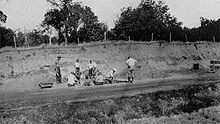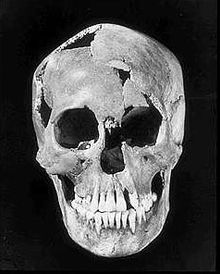- Minnesota Woman
-
 Second redigging of the "Minnesota Woman" site by the University of Minnesota. Looking toward the west bank of the highway cut. Unearthed in 1931.
Second redigging of the "Minnesota Woman" site by the University of Minnesota. Looking toward the west bank of the highway cut. Unearthed in 1931.
"Minnesota Woman" is the name given to the skeletal remains of a woman believed to be at least 10,000 years old. The bones were found near Pelican Rapids, Minnesota on June 16, 1931, during construction on U.S. Route 59. The bones were brought to Dr. Albert Jenks at the University of Minnesota, who identified them as the bones of a woman who was mature, but who had never borne children. The woman had two artifacts—a conch shell pendant and a dagger made from an elk's horn.
The road crew dug up the site without an investigation by archaeologists, so some of the exact details of the woman's death were hard to determine. The site indicated that the woman had not been ritually buried, and there was a thin layer of broken clam or mussel shells over the body. This led to the hypothesis that the woman had drowned, either by breaking through the ice or by falling off a boat, and that her body had been covered in mud at the bottom of a glacial lake.
Before 1926, most scientists theorized that human beings had only appeared in America within the last couple thousand years. The discovery of Minnesota Woman provided evidence that humans had been in America for many thousand years before that. Scientists now recognize the girl as a Paleo-Indian whose ancestors had come across the Bering land bridge during the Pleistocene Ice age. Radiocarbon dating places the age of the bones between 5000 BC and 1000 BC, somewhere near the end of the Eastern Archaic period.
References
- "The 'Minnesota Woman' - History of Otter Tail County". http://www.co.otter-tail.mn.us/history/countyhistory_mnwoman.php. Retrieved 2006-11-20.
- Lass, William E. (1998) [1977]. Minnesota: A History (2nd ed.). New York, NY: W.W. Norton & Company. ISBN 0-393-04628-1.
Categories:- Otter Tail County, Minnesota
- Pre-state history of Minnesota
- Archaeological sites in Minnesota
- Native American history of Minnesota
- Native American history
- Indigenous peoples of North America stubs
- Minnesota stubs
Wikimedia Foundation. 2010.

